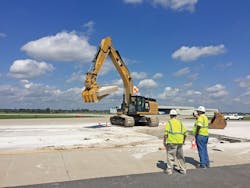The Indianapolis International Airport has been named the “Best in North America” by the Airport Council International’s airport service quality awards for the last four years in a row.
One thing that the Indianapolis Airport Authority (IAA) prioritizes in order to preserve this reputation is maintaining the infrastructure of its aging airport. Every year, IAA conducts a study of its airfield pavement, using indicators such as a pavement condition index (PCI) to evaluate the needs of its roadways.
In 2016, IAA determined that the airport’s Taxiway Bravo (Taxiway B) was in dire need of repair based on deterioration that they were seeing. “This taxiway serves as one of our primary off-ramps to get to our terminal,” Shannetta Griffin, senior director of planning and development at IAA told Roads & Bridges. “So this becomes critical, especially for FedEx, one of our largest providers here at the airport.” Indianapolis holds the second largest cargo facility in the country for FedEx.
Thirty concrete panels had to be removed before repaving the taxiway.
Getting started
The airport partnered with Hanson Professional Services to design the rehabilitation project on Taxiway B. The team at IAA was awaiting grant funding from the Federal Aviation Administration (FAA) when design work for the taxiway began in August 2016.
Paving on the project began in mid-September, after Milestone Contractors was brought on board to do the job. The team at Milestone landed the contract since they were the lowest bidder, and all projects at the airport are publicly bid. “They have done work before [with IAA], and the partnership has been very good in regards to the other paving projects that they had done before,” Griffin said.
When the team from Milestone first came on the scene, the issues with Taxiway B were not particularly apparent, until the project engineer explained the problems. “There was an issue with the epoxy that they used with the dowel bars,” Matt Gessner, project manager at Milestone, told Roads & Bridges. “I think they replaced this back in ’95, and it was causing big problems for the taxiway.”
“Little pieces were starting to chunk out from the movement of the dowels,” Milestone Concrete Ops Division Manager Steve Friess told Roads & Bridges. “When little pieces start to chunk out, of course, you can’t have that around jet engines, so they felt it needed to be replaced.”
Crews finished paving the taxiway lanes in four days.
A tight schedule
A 70-day closure was allowed for the rehabilitation of Taxiway B, giving Milestone a short time frame to remove and replace the pavement. “It’s a heavily used taxiway,” Gessner said. “They wanted it open as quickly as they could.”
Working inside the airport, the project required a heavy security presence in order to prevent possible incursions with an aircraft. A guard was required to be no more than 500 ft from the crews, and one guard was needed for every six crew members.
Taxiway B had two 7,000-ft (2.8 total lane-miles) lanes that needed to be removed and replaced. In addition, 30 panels had to be replaced individually throughout the taxiway, and the team had to maintain access to a fire station in the middle of the lanes. “So in doing the 30 miscellaneous panels, we did six or eight panels right in front of the fire station, so we could keep access to the fire station when we were doing the long runs,” Friess said. “We removed the 7,000 ft in five days.”
One of the first things Milestone did on the job was to create a hall road about 1,200 ft off the main road for access. “We had to build something that would withstand the wear and tear of thousands of trucks loaded with fresh concrete and with panels that were taken away off the jobsite,” Gessner said. “We wanted something we could make quickly, since the schedule was tight, and remove when we were done.”
The crew removed the road using a Caterpillar 349E hydraulic excavator and a Cat 336 track excavator, both with pavement removal buckets on them. Two longitudinal passes with a Vermeer rock saw aided the removal process. The team was able to remove all 14,300 ft of pavement with no stall damage to the adjacent panels. This accomplishment became a big deal for Milestone since the FAA requires that damage to more than 10% of any joints mandates taking out the adjoining panel, which can be an expensive task. At 16 in. deep and 18.75 ft wide each, the lanes on Taxiway B were removed down to the FAA P-306 econocrete. “And we weren’t allowed to damage the econocrete,” Friess said. “Any damage that occurred, we’d have to fix ourselves.”
A P501 concrete mix was to be applied on the taxiway, and expensive testing was conducted daily on the mix. “[On] our 4,000-yd days, we tested as many as 75 times to keep in spec,” Friess said. “And yet, we never got into any warning zones—never once were we anywhere near the warning areas that everybody looks for to start being concerned about the mix getting out of spec.”
Once the pavement-removal process was complete and the contractor cleaned up the econocrete, the 30 panels were ready to be replaced. Once the panels were in place, the crew went to town pouring the new concrete onto the taxiway lanes, finishing paving in four days.
For the base of the pavement, crews put down a ½-in. layer of choke stone as a bond breaker on the 6-in. existing econocrete base. Thirty-two tri-axle dump trucks were utilized to haul concrete from the central mix batch plant, about 20 minutes away from the jobsite. Approximately 10-cu-yd loads were batched into each truck. A Gomaco 2800 two-track paver poured the slip lanes at a width of 18.75 ft, and a Terramite paving roller screed was used to pour the isolated panels. Sawcutting operations started roughly 10 hours after the first placement of pavement and took place overnight.
After pouring the concrete, the pavement met strength after an 18-hour cure time, with a heavy layer of W.R. Meadows 1600 water-based curing compound applied. The average strength achieved on the concrete was 719 psi, and the average thickness achieved was 15.5 in.
Milestone was able to complete its work ahead of schedule. “We did have a very tight construction schedule that was already implemented within the plan,” Charles Bischoff, project manager for IAA, told Roads & Bridges. “But the contractor was able to exceed that by two days, completing the project two days ahead of schedule.” The early completion included removing the temporary hall road.
Milestone was given a 70-day window to remove and replace the pavement on Taxiway Bravo.
Plus for the airport
One of the accomplishments of the removal and replacement process for the taxiway was implementing a sustainable construction approach. The project brought forth an abundance of concrete pavement removal that added up to 13,907 cu yd in total. Milestone prepared a large area at its central mix plant site so the slabs could be stockpiled. The slabs could later be crushed on-site and used as recycled aggregate as a replacement in future concrete pavement or for aggregate sub-base material.
“Recycling like this was a very innovative way for our contractor,” Griffin said. “They took it on themselves to go find land to [store] this pavement so that if we have other projects, now we can recycle that and use that base course for something else—that certainly aligns itself for what we’re trying to do to be sustainable.”
Griffin added that a big plus for the airport as a result of the completion of this project is having a longer useful life for the airfield pavement and restoring full airport operations. “From an operational standpoint, there’s a lot of aircraft that land and take off in a short period of time,” Griffin said. “So being able to have the taxiway back open helps with that operation.”


